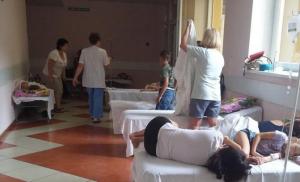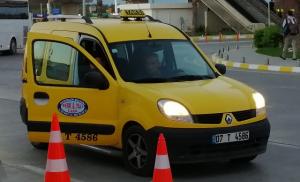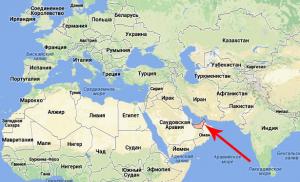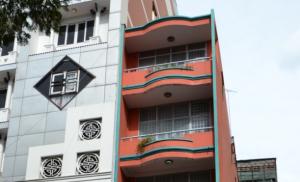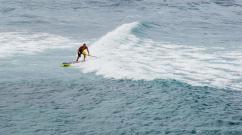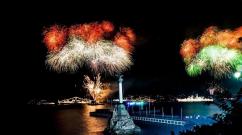Which city is the cultural capital of Sri Lanka. Sri Lanka's cultural triangle
ශ්රී ලංකා ප්රජාතාන්ත්රික සමාජවාදී ජනරජය
Capital- city of Sri Jayewardenepura Kotte
Square- 65,610 sq. km.
Population— 21.6 million people
Language- Sinhala and Tamil
Form of government- mixed republic
Independence date (from Great Britain)— February 4, 1948
Largest city —
Currency— Sri Lankan rupee
Time zone — +5:30
Dialing code — +94
At the official level the country is called Democratic Socialist Republic of Sri Lanka. The state is located in southern Asia on the territory of the island of Sri Lanka in the southwestern part of the coast of Hindustan. Until the country gained independence, it was called Ceylon. The official capital of the state is the city of Sri Jayewardenepura Kotte, where the supreme court and parliament are located. However, the actual capital is the city. The residence of the country's president is located here and the government meets. Dondra - southern cape Islands, Dutch Bay - western.
Sri Lanka - video
The island of Sri Lanka is washed by the Indian Ocean and the Bay of Bengal. The Palk Strait and the Gulf of Manara separate Sri Lanka from Hindustan. In the past, the island was connected to the mainland by the so-called Adam's Bridge (a sandbar in the Palk Strait), but according to legend, the bridge was destroyed during one of the earthquakes. Located in the center of the country mountain ranges, the topography of the rest of the territory is predominantly lowland. Highest mountain peak is located at an altitude of 2,524 meters above sea level and is called Pidurutalagala. The island's subequatorial monsoon climate is determined by the northeast and southwest monsoons that blow throughout the year.
The largest rivers Sri Lanka are Kalu, Aruvi-Aru, Kelani, Mahaweli-Ganga.
According to the government census conducted in the summer of 2013, the country is home to about 21.6 million people. By nationality we can distinguish Sinhalese (about 75%), Tamils (about 18%), Sri Lankan Moors (about 7%), burghers (about 0.3%), Veddas (about 1 thousand people). Religiously, the country's population is divided into followers of Buddhism, Judaism, Christianity and Islam - 70%, 15%, 8% and 7%, respectively.
The country's calling card is tea. In terms of its production volumes, Sri Lanka is third in the world, second only to China and. The country has achieved the greatest success in mining precious stones, rubber and cinnamon. The textile industry occupies a leading position in terms of export volumes (about 63%), agriculture- about 20%. The country has a fairly extensive network of bus routes, which are served by both the state bus company and private enterprises. You can get to any corner of the island by bus, but traveling there will be little fun due to dirt, dust, crowding and low speed (no more than 45 km/h). There are also more comfortable buses, but getting on them is quite difficult - tickets must be booked in advance at bus stations or at transport agencies.
It's worth mentioning railway transport islands. The railway connection connects large cities with each other. The trains have carriages of different classes with and without air conditioning. A world-famous restored train, which was built back in 1928, runs along one of the routes. Sri Lanka has international airport Bandaranaike, located about 35 kilometers from. The airport was built by the British in 1940 and was initially used as a military airport.
Sights of Sri Lanka
Bambarakanda waterfall


Waterfall "Bridal Veil"
On the territory of the state there are famous plantations Ceylon tea , which was first brought here from China in 1824. In the second half of the 19th century, tea began to be grown here on an industrial scale for the first time - this was done by James Taylor, a planter from Scotland, who planted about 80 hectares of land with tea.





1. In Sri Lanka, national conflicts occur quite often within the country, so do not be surprised by the large number of military personnel on the streets and roadblocks. Railway stations and bus stations in the country are usually surrounded by fences, and all passengers must present identification upon entry. In the southern part of the country the situation is somewhat calmer, so there are usually fewer checks here.
2. When visiting restaurants or cafes, pay attention to what the food you ordered is prepared from, since all the dishes here are spicy. To avoid misunderstandings, ask the waiter serving your table about the composition of a particular dish. You should choose sauces especially carefully. If you have eaten very spicy food, then you do not need to wash it down with water - it is better to eat bread or unleavened flatbread.
3. If you want to order tea in a cafe, take the trouble to explain how you need to brew it, since here they do it a little differently than in Europe.
4. The main dish in Sri Lanka is rice, which is served on a separate large plate, along with small saucers with various spices and seasonings.
5. Do not be alarmed if you are offered to buy soft drugs on the street - this is considered a common occurrence here, despite the fact that the laws of the country provide for the highest penalty for distribution and possession of drugs - the death penalty.
6. Be sure to wash your hands very thoroughly before eating. It is better to scald vegetables with boiling water. Water should only be drunk from plastic bottles with factory covers.
7. Residents of the country are very friendly with tourists, although this attitude is not always pleasant, as sometimes it develops into intrusiveness (this mainly applies to local street vendors and tour guides).
8. In Sri Lanka, entry to many beaches is free, however, the beaches of some hotels are closed. Hunting animals and collecting corals is strictly prohibited here.
9. It is best to dress in the country in light clothes made of natural fabric in light shades. If you are going to climb the mountains, be sure to take warm clothes with you.
10. When visiting temples, you must take off your shoes and hats. It is prohibited to enter such places wearing short skirts and shorts, as well as bare shoulders and backs. Do not turn your back on Buddha statues, do not show your feet or the soles of shoes to others, do not take photographs of the local population without permission, and do not offend cows, as they are sacred animals here.
11. It is not at all necessary to leave a tip in restaurants or hotels. Sometimes they are included in the total bill for a service or meal.
12. The voltage in the local power supply is 230-240V, and the sockets are three-pin, so to use them you need to purchase a special adapter.
Amazing place Ceylon Island! Today he is better known as Sri Lanka. Thousands of tourists come here to see stunning landscapes, admire sunsets, get lost in impenetrable jungles and swim in warm waters. Indian Ocean. But this exotic country can offer tourists not only a beach holiday. Sri Lanka has enough architectural and historical monuments, many of which were included in the list World Heritage UNESCO.
As in others Asian countries, Sri Lanka also has its own “golden triangle” A must when exploring the country - three magnificent cultural capitals in the central province of Ceylon. These are Anuradhapura, Polonnaruwa and Kandy.
True, in addition to these cities, there are attractions no less worthy of your attention, which are also included in this cultural triangle: ancient city Sigiriya, Dambulla cave temple, Nalanda ruins, Mihintale Buddhist temple ruins and others.
Anuradhapura
The first capital of Ceylon, which is inextricably linked with the birth of Buddhism, is Anuradhapura. A number of religious buildings in this city directly confirm this. There are many temples and palaces here that were built back in the 4th century BC.
If you drive 12 km from Anuradhapura, you can get to - the cradle of Buddhism in the country. Not only tourists, but also pilgrims come here, considering Mihintale a religious center.
It is located on Mount Mahinda and is a complex of ruins, dagobas, caves and pagodas. Visiting the mountain is free (except for entrance to the Mango Plateau - 500 rupees). But the climb up the mountain is difficult - 305 meters or 1840 steps.
One of the most unique monuments Sri Lanka is Sigiriya– a 180-meter rock, on the top of which are the remains of the palace-citadel of King Kasyapa. Today, little remains on the 1.7 hectare terrace: the paws of the “lion platform”, a giant royal throne, a gallery with frescoes and a “wall of mirrors”. True, restoration work is underway.
Amazes and cave Dambulla Temple, a monastery that is more than two thousand years old. Its walls and ceilings are painted with colorful frescoes, and the temple itself contains many Buddha statues. Today in this Buddhist monastery monks find their shelter.
Polonnaruwa
From former splendor ancient capital Polonnaruwa there is nothing left today. This is the medieval capital of Sri Lanka (it was the capital for about 200 years), a museum city today, with perfectly preserved palaces and stupas (the three largest on the island), Buddha statues and luxurious gardens. For several centuries the city was “hidden” in the jungle until English hunters discovered it. And only at the beginning of the 20th century archaeological excavations began. The city has a rich past, so lovers of ancient history come here.
The most interesting place is the building of the Council of Ministers of Nissankamalla, on the columns of which the entire management system is painted. Not far from this building in ruins you can see the remains of the audience hall of King Nissankamalla with the Lion Throne, the King's Palace, which they are now trying to restore, several Hindu temples
Be sure to visit the Polonnaruwa Archaeological Museum, the exhibition of which includes household items, jewelry, coins, and religious statues that were found during excavations in the city. Built in the 12th century, the Hatadage Temple, with frescoes and paintings, is one of the most beautiful in Polonnaruwa; Watadage Temple with a small stupa that once housed the relic of the Tooth of Buddha (now located in Kandy).
Not far from the city is the Lankatilaka temple, decorated with figurines of gods and floral patterns. It is famous for its 13-meter tall Buddha statue.
Nearby, to the north of the archaeological zone of Polonnaruwa, there is the Gal Vihara Temple (Stone Temple) with huge Buddha statues carved into granite rock that look very realistic.
Kandy
The third capital of the "golden triangle" and last capital ancient kings - Kandy. An original city with original residents who honor the traditions of the past; even during the time of British colonization it retained its historical heritage, customs and beliefs. It is the cultural capital of Sri Lanka. In the center of the city is the creation of the last king of Kandy - a beautiful artificial lake. In the center of a lake on an island summer residence- Royal Palace.
And on its shore is the Temple of the Sacred Tooth Relic, one of the most significant monuments in Kandy. It is decorated with painted ceilings and wood carvings, and the entrance doors are decorated with silver and ivory. Previously, only kings and clergy had access to the shrine.
Now times have changed: every year in August, during the Esala Perahera Festival, the shrine is brought to public display. But the temple also has many other valuables - ancient handwritten books, manuscripts, Buddhist scriptures, Buddha figurines made of precious metals and stones.
To the north of the temple are the Royal Palace, the Queen's Palace and the Audience Hall. Within the walls Royal Palace Today there is an Archaeological Museum with a magnificent collection of royal regalia, jewelry and household utensils. Nearby are the former bathhouse of Queen Ulpe Ge, three Hindu temples and the oldest building in Kandy - the Niai Devala Temple.
Since Kandy is the religious capital of Ceylon and the center of Buddhism, the city is home to two ancient monasteries - Asgiriya Monastery and Malwatte Monastery. In the vicinity of the city there are many other religious centers, Buddhist temples, which are famous for their frescoes and wood carvings.
Drive through the Golden Triangle on your own
If you are relaxing on the beaches of Sri Lanka and decide to travel through the cultural capitals of the country on your own, you will need at least 5-7 days. All these cities are connected to each other in a beautiful by bus. You just have to plan your route in advance. Buses operate only during the daytime. Depending on the distance between cities, the cost of a ticket varies between 30-300 rupees (from 20 cents to 2 dollars).
Renting a car with a driver will cost $200-500 for 5 days, renting a motorcycle will cost $7-10 per day. There is no need to pay to enter the Golden Triangle. But visiting its attractions is not cheap: you will have to pay for each separately (museums, temples, etc.). We bring to your attention the prices for visiting the main attractions: Anuradhapura - $30, Dambulla - $12, Sigiriya - $30, Polonnaruwa - $25
Fly to Ceylon just to swim in the Indian Ocean and bask in the sun is pointless, if only because besides the jungle and endless beaches there is a lot of interesting things on the island.
Let's start with the fact that over the centuries Sri Lanka 8 (!) capitals changed. As a result, of the 130 world historical values protected by UNESCO, seven are located here: Adam's Peak - the famous mountain, shaped like a pyramid, over the mirages of which scientists have been puzzling for many years; An invaluable relic for Buddhists - the Tooth of Buddha; The Bo tree is the oldest historically documented tree on Earth.
It is best to start your journey from today's capital - Colombo. This city was founded by the Arabs, and in 1517 the Portuguese built a fort here, in 1948 Colombo became the capital of the state Ceylon, and in 1972 the Republic Sri Lanka. The mixture of cultures affected its appearance: Eastern temples here coexist with mosques and Catholic cathedrals; colonial mansions with skyscrapers, and huge shopping centers with small benches. Unlike the resort areas of the island, there are practically no Europeans on the streets of Colombo; usually in these cases there is no discomfort, and only children can be surprised by their “exotic” appearance.
Actually on Sri Lanka 2 capitals: Colombo and administrative Jayavaranapura. The first capital of the island known to us was Anuradhapura, located in the north of the island. It’s worth going here to see one of the tallest weapons built in ancient times - a stupa 120 meters high, as well as the Bo tree, sacred to Buddhists.
In the center Sri Lanka
The golden triangle Polonnaruwa-Singiriya-Dambulla is located. They are several hours away from each other. They are located in the middle of the jungle, so there is a high probability of meeting elephants, monkeys, mongooses, snakes on your way, and in the evening you often have to brush off bats. All these horrors are redeemed by the beauty that can be seen here.
In Polonnoruwa there are four huge Buddha statues carved directly into granite rocks, representing one of the most famous rock groups in the world. Here, right in the middle of the jungle, there are the ruins of ancient palaces, baths, chapels, as well as Buddhist and Hindu temples. Not far from Polannoruva there is a reservoir from the 12th century, Parakrama Samudra, which is still considered one of the largest reservoirs on the entire island.
The rock - the Singiriya fortress - is one of the most legendary places on the island. No one knows how a huge block could appear on the plain. Another miracle of Singiriya that is worth seeing is the “mirror corridor”, the walls of which are in some unknown way polished to a mirror shine. From the top of the rock there is a stunning view of the surrounding area.
Another city worth visiting is Kandy, it is cultural capital Sri Lanka. It is famous all over the world primarily due to the Dalala Maligawa Temple, where the Sacred Tooth Relic of Buddha is kept. After an attack on the shrine by terrorists, the Tooth was hidden from prying eyes in a casket weighing 120 kg. Only once a year, at the beginning of August, during the ten-day Perahera holiday, a piece of Buddha leaves the temple, the casket is taken out on an elephant, which is accompanied by dozens of his fellows, decorated with bells, hundreds of torchbearers, musicians, acrobats and dancers. For Buddhists, this holiday is one of the most significant of the year, and therefore attracts thousands of tourists to Kandy.
Just four kilometers from the city is the Royal Botanical Garden, one of the largest in Asia and the most beautiful in the world. There are more than 170 species of ornamental orchids in the palm grove.
The main thing to remember is Sri Lanka, - look carefully not only around, but also under your feet, because the fauna here is very rich, and anything can crawl below.
On the island Ceylon so good that you want to follow the example of Arthur C. Clarke and stay here forever. After all, on Sri Lanka the most beautiful sunsets, and according to one legend, this is where the Garden of Eden is located. About what's on Ceylon Once upon a time there was paradise, Chekhov said, but he showed perseverance and did not stay on the island.
Many people know about the beautiful resorts on the island in the Indian Ocean. Where is Sri Lanka?
The state is located on an island with the same name. Let's see where Sri Lanka is on the world map. Surely everyone knows how to find India on the map. The island is located near the Hindustan Peninsula, off its southeastern shores. The location of Sri Lanka, its proximity to the equator, determines the climate of the island. The climate of Sri Lanka is monsoonal, with wet and dry seasons.
History of Sri Lanka
This state has ancient history. The first inhabitants appeared on the island in the 6th century BC (the official opinion, the results of archaeological excavations do not confirm it). Three centuries later The Buddhist religion appears in the state.
Since the 3rd century AD, the kingdom of the Sinhalese appeared on the island of Sri Lanka (in Russian translation - “blessed land”). In the 13th century, the decline of the monarchy began. In the 16th century, the island was captured by the Portuguese.
In the 17th century, the newly formed Holland (Kingdom of the Netherlands) displaces the Portuguese colonists. At the beginning of the 19th century, the British Empire declared Ceylon (this name appeared after the Portuguese invasion) as its colony. There were on the island tea plantations created, and Ceylon became one of the main suppliers of tea.
After the Second World War, almost all of Great Britain's colonies became independent (however, the vast majority independence was relative, because the USA, the stronghold of imperialism, has become the metropolis). In 1948, Ceylon changed its status from “colony” to “dominion”. In 1972, the state returned to its former name - Sri Lanka.
In 1983, civil war began in the country. The main participants in the war were the government and the guerrilla movement the Liberation Tigers of Tamil Eelam. The fighting went on with varying degrees of success; several times the government sought a truce. In 2009, partisanship was eliminated and the civil war ended.
The name of the country changed several times: at first it was called Sri Lanka, later Ceylon, and since 1972 the previous name has returned. Today the state is called Democratic Socialist Republic Sri Lanka. Capital and largest city countries - Colombo.
Sights of Sri Lanka
Sri Lanka is a country of ancient culture, interesting for tourists. There are located popular resorts, where many thousands of tourists come. In addition, there are sacred places for people who practice Buddhism, and many pilgrims come here from all over the world. On the map of the island there is There are many interesting sites that tourists visit. Popular excursion tours:
- Colombo;
- Halle;
- Anuradhapura;
- Dambulla;
- Sigiriya;
- Polonnaruwa.

Temple of the Tooth Relic
To see this attraction, need to go to Kandy city(one of the tea varieties is named after him). In the temple you can see a golden stupa, inside of which lies a relic - the tooth of Buddha.
There is an interesting story associated with this relic. After the deceased Buddha was sent to the funeral pyre (540 BC), four teeth were removed from the ashes. One of them ended up on the island of Sri Lanka and became a talisman for the royal dynasty. At the beginning of the 18th century, the talisman came to the city of Kandy. For storage a temple was built for the legendary tooth. The relic itself was hidden in seven caskets, each of them was hidden inside another (analogous to a Russian nesting doll).

Botanical Garden in Peradeniya
After seeing the sights of the city of Kandy, it is worth visiting the suburb of Peradeniya, where a large botanical garden is located. Fans of tropical exotics will visit the greenhouse of orchids - the queens of tropical forests.
In the palm alleys You can find different types of palm trees - date, coconut and so on. One of the varieties of palm trees, talip, is notable for the fact that in the 50th year of its life it blooms and immediately dies. The leaves of the thalip palm “have a history”: Buddhist texts were once written on them, and today the horoscope is written down.
The botanical garden has a Memorial Garden - trees planted here grow famous people(among them the Russian Emperor Nicholas II and the first cosmonaut Yu. Gagarin).

Ancient city of Anuradhapura
This oldest city in Sri Lanka and the first capital of this state. As a result of archaeological research, it was possible to find out that the first buildings appeared not in the 6th, but at least in the 10th century BC.
Since the 1950s, residents of Anuradhapura have been moved to the so-called new city" This was done to protect archaeological sites. IN " old town» lovers of ancient history drop by.

Plateau "End of the World"
This outlandish name was given to two observation platforms, one of them being called the “Little End of the World”, and the other – the “Big End of the World”. The only difference is the depth of the cliff. Co observation platforms there are views of the mountains and valley.
Interesting fact: at both observation platforms there are no fences or railings. Just beyond the edge there is a sheer cliff. The price of carelessness is very high: an awkward step can result in a fall from a great height and death.

Adam's Peak
This is the second highest mountain in Sri Lanka. The name of the mountain is translated from Sinhala as “mountain of butterflies”. On the flat top you can see a depression similar to a human footprint. According to legend, this is the footprint of the legendary saint - Buddha. Another legend says that the water collected in this depression-trace has healing properties.
A small open temple was erected at the top of Adam's Peak. Buddhist pilgrims and tourists come here.

Beach resorts in Sri Lanka
The wonderful climate and warm sea attract lovers of surfing, diving and just the lazy beach holiday. The map of Sri Lanka has many beach resorts, where excellent conditions are created for vacationers. Here are some of the resorts:
- Beruwela;
- Koggala;
- Mirissa;
- Negombo;
- Colombo.
Tea kingdom
Impossible to leave this beautiful island without packaging with the famous tea. It was from here that tea came to England, and then to Europe. Fine varieties of tea are grown on numerous tea plantations. Here you can buy real high-quality elite tea at very affordable prices.
Video
The video will introduce you in more detail to the history of this remarkable country.
Sri Lanka is the island of Sun and Sand. More than one thousand kilometers sandy beaches with palm trees surround Sri Lanka. Until 1972, this country was called Ceylon. And although its name has changed, the best black tea in the world, Ceylon, is still grown there. In addition to beautiful beaches and tea, Sri Lanka has large number historical sites ranging from Buddhist and Hindu monasteries and temples to orchid gardens and colorful festivals.
Geography of Sri Lanka
The island nation of Sri Lanka is located in the northern Indian Ocean off the southern coast of the Hindustan Peninsula in South Asia. Sri Lanka is washed on all sides Pacific Ocean. In the northwest it has sea border with India, and in the southwest with the Maldives. Total area this country – 65,610 sq. km
In the center and south of Sri Lanka there are foothills and mountains, and the rest of the territory is plains and coastal lowlands. The largest local peak is Mount Pidurutalagala, whose height reaches 2,524 meters.
The longest river in Sri Lanka is the Mahaweli, its length is 335 km. The Mahaweli flows through the central, northern and eastern regions of this country, and flows into the Bay of Bengal.
Capital
Sri Jayawardenepura Kotte is the capital of Sri Lanka. More than 120 thousand people now live in this city.
Official language of Sri Lanka
Sri Lanka has two official languages- Sinhala and Tamil.
Religion
More than 70% of the population professes Buddhism (specifically Theravada Buddhism), more than 12% Hinduism, almost 10% Islam, and about 7% Christianity.
State structure
According to the current Constitution, Sri Lanka is a presidential-parliamentary republic. Its head is the President, elected for 6 years by universal suffrage. The President is the Supreme Commander and appoints ministers.
Sri Lanka's unicameral parliament has 225 members elected by popular vote every six years. The President of the country has the right to dissolve Parliament.
Administratively, Sri Lanka is divided into 9 provinces and 25 districts.
Climate and weather
Due to its proximity to the equator, the climate in Sri Lanka is tropical and warm. The average annual air temperature is +28-31C. In hilly areas and foothills - +20C, and in flat and coastal areas- +27C.
The monsoon (rainy) season continues from May to July in the central, western and southern regions of the island. In the northern and eastern regions, the rainy season occurs in December and January.
The best time to visit Sri Lanka is from November to April ( southwest coast and mountains) and from May to September ( east coast). Thus, you can visit Sri Lanka all year round, because... there is always a dry season on some part of this island.
Sea in Sri Lanka
Sri Lanka is washed on all sides by the Pacific Ocean. The length of the coast is 1,585 kilometers. Local beaches surrounded by palm groves. Average temperature sea in January - +28C, and in July - +27C.
Rivers and lakes
There are more than 100 rivers in Sri Lanka. The longest of them is Mahaveli, its length is 335 km. The Mahaweli flows through the central, northern and eastern regions of this country, and flows into the Bay of Bengal.
Story
The history of civilization in Sri Lanka goes back more than 2.5 thousand years. In former times this country was called Ceylon. The first settlers were the Veddas. Around the 6th century BC. The Sinhalese arrived on this island and founded their kingdoms there. From the 3rd century BC. Buddhism begins to spread there. Until the 11th century, the capital of the most powerful Sinhala kingdom was Anuradhapura, and then it was moved to Polonnaruwe.
In 1505, the Portuguese arrived in Sri Lanka and monopolized the spice trade. By 1658, the Sinhala kings, with the help of the Dutch, were able to expel the Portuguese from the island.
The Dutch were more interested in trade and profit than in governing this country. Therefore, they did not resist the British very much when the British sailed to Sri Lanka in 1796. In 1815, Britain defeated the Sinhalese kingdom of Kandy, thereby establishing control over the entire island.
It was not until 1948 that Sri Lanka achieved independence. In 1972, this country received its modern name - Sri Lanka.
Sri Lankan culture
Sri Lanka has a multi-cultural society consisting of Buddhists, Hindus, Muslims and Christians. Therefore, the culture there is very interesting and diverse. Travelers will be able to experience colorful and unique festivals and celebrations in Sri Lanka.
In January, Sri Lankans celebrate New Year, Duruthu Perahera (held in memory of Buddha's visit to this island), Pongal (Hindu harvest festival); in February/March - the Buddhist holiday Navam Perehera and Maha Shivarathri Day; in April/May - Sinhala and Tamil New Year, Eid ul-Adha; July/August - Kandy Perahera and Vel Festival; September – kite festival, Hindu festival Navarathri; October/November – Ramadan, Lilavali (“Festival of Lights”); December - Sangamittha Perehera.
All these festivals are colorful processions, they are always accompanied by elephant parades, music and dance performances, fireworks and theatrical performances.
Kitchen
Sri Lanka's cuisine reflects the multi-ethnic composition of the island's population. Home food local residents– rice and curry made from a mixture of spices, herbs and coconut milk. In general, almost all local dishes are prepared using coconut milk and spices.
Samba is pearl rice and is eaten on special occasions. During festivals, yellow rice is made, cooked in coconut milk and lightly seasoned with spices. Another popular rice dish is Kiribath (milk rice).
In addition, the people of Sri Lanka are real experts in preparing fish and seafood dishes. Fried fish is served with chips and salad, while curry fish is served with rice.
Popular dishes - Mallung Curry (finely chopped dried vegetables, shrimp with grated coconut and spices), Sambol (spicy hot dish), Pol Symbol (grated coconut, onion, red pepper, lime and salt), Seeni Sambol (fish with spicy onion ), Lamprais (curry, cutlet, shrimp paste, eggplant curry, rice wrapped in banana leaf and baked), Buriyani (rice in meat broth), and Thalaguli and Wattalapam sweets.
The traditional soft drink in Sri Lanka is black tea, which is most often drunk with sugar and milk. Sometimes crushed ginger is added to tea. In addition, the inhabitants of this island love coffee, fruit juices and coconut milk.
Alcoholic drinks are also made in Sri Lanka - low-alcohol toddy (from juice coconut tree) and “arrack” (30-40%, from coconut palm sap).
Sights of Sri Lanka
According to official data, there are several hundred Buddhist and Hindu monasteries in Sri Lanka. And if you add to this temples, palaces, mosques, cave complexes, then the number of local attractions will reach several thousand. In our opinion, the top ten best attractions in Sri Lanka may include the following:
- Dalada Maligawa Buddhist Temple (Housing Buddha's Tooth)
- Fort in Colombo
- Sigiriya Fortress
- Dawatagaha Mosque in Colombo
- Cave Buddhist temple in Aluvihara
- Kochchikade Hindu Monastery in Colombo
- Ruins of the city of Anuradhapura
- Palace of King Kassiapa on Lion Mountain
- Cave Buddhist temples Dambulla
- Buddha's footprints on Sri Pada mountain
Cities and resorts
The largest cities in Sri Lanka are Kandy, Tricomalee, Kurunegala, Galle, Ratnapura, Kurunegala and Colombo.
Sri Lanka has many kilometers of beautiful beaches. Many of these beaches are located in picturesque bays surrounded by palm groves.
The best beach areas are Colombo, Trincomalee, Bentota, Arugam Bay, Hikkaduwa, Kogalla, Negombo and Kalutara. Many tourists believe that the most best beach in Sri Lanka it is Mount Lavinia near Colombo. All local beach resorts have good recreational infrastructure. There are also excellent opportunities for surfing, kitesurfing, wakeboarding, swimming, diving, fishing, spearfishing and scuba diving.
Near some beach resorts (for example, Trincomalee) there are hot springs, and therefore tourists can take medicinal baths there.
Souvenirs/shopping
From Sri Lanka, tourists usually bring handicrafts, ceramics, jewelry, masks, leather goods (for example, bags), batik fabric, souvenirs made from coconut shells, spices, and, of course, local (“Ceylon”) black tea.

